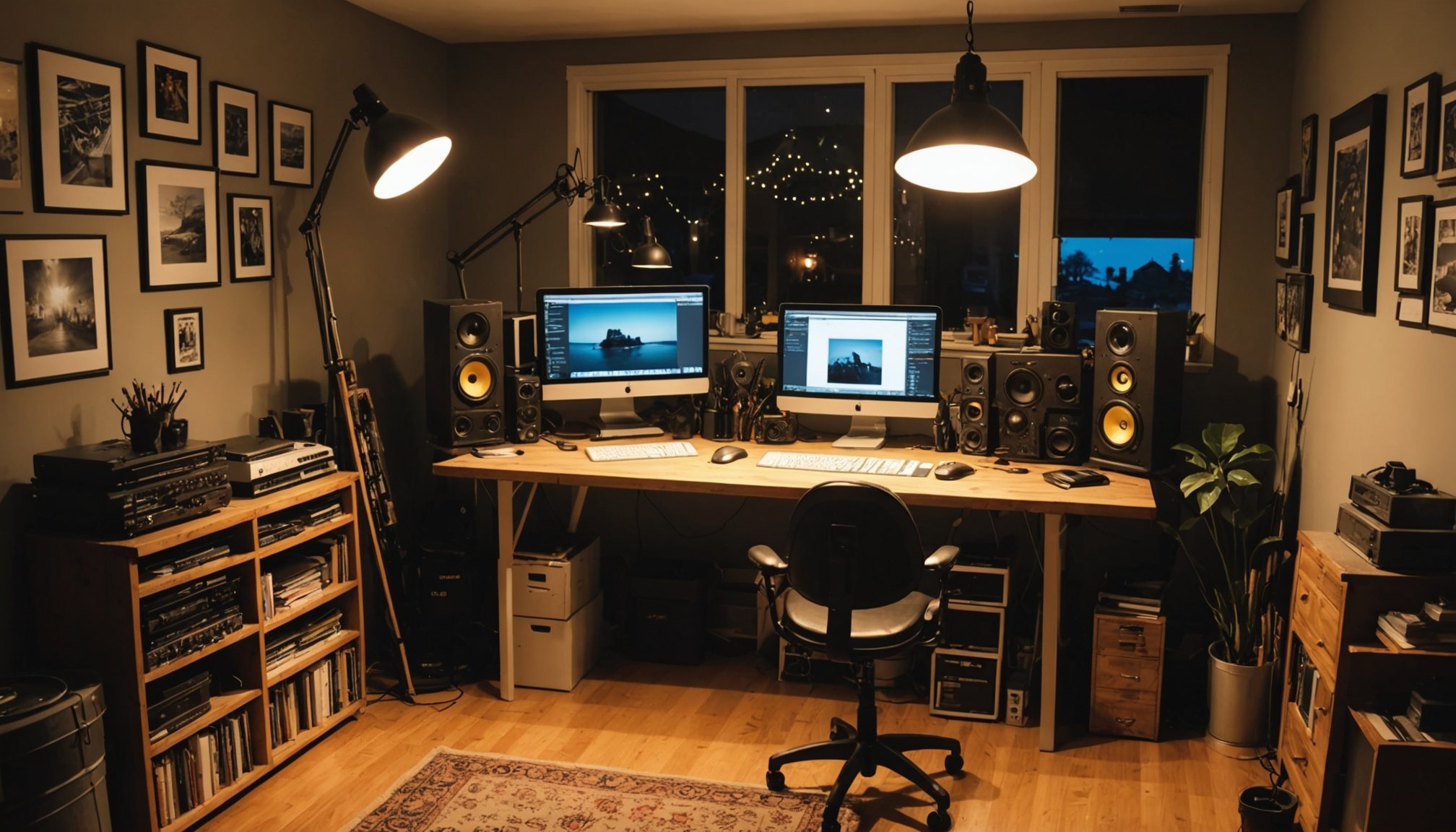Understanding the Importance of Lighting in Art Studios
The significance of lighting impact in art studios cannot be overstated, as it profoundly affects the overall art studio atmosphere. Proper lighting plays a crucial role in enhancing creativity, enabling artists to perceive their work accurately. The right lighting conditions can make intricate details more visible and colours more vivid, influencing both the creative process and the artist’s perception.
Psychologically, different lighting types can have varied effects. Warm lighting often evokes a sense of comfort and relaxation, which can be beneficial for fostering a creative flow in a creative space environment. Conversely, cooler lighting tends to energise, making it suitable for detail-oriented tasks. Understanding these subtle psychological effects aids artists in designing a studio environment that supports their creative needs.
Additional reading : Transform Your Snug Studio: Craft a Serene Bookshelf Hammock for the Ultimate Reading Haven
Furthermore, the art studio atmosphere should be versatile, allowing for adjustments based on the project or mood. This adaptability ensures that artists can maintain a conducive environment for creativity and productivity. Artists should consider how different lighting can highlight textures and forms, adding an extra layer of dimension to their work. These considerations highlight the essential role of lighting in cultivating a studio space conducive to artistic inspiration and excellence.
Types of Lighting for Home Art Studios
Choosing the right lighting for a home art studio is vital for enhancing the art studio atmosphere and optimizing the creative process. The distinction between natural vs artificial lighting plays a crucial role in forming a conducive creative space environment.
Also to see : Revitalize Your Home: Enhance Air Quality with Himalayan Salt Lamps and Living Air-Purifier Plants
Natural Lighting Solutions
Maximizing natural light can significantly influence an artist’s work. Daylight provides a balanced light that is ideal for discerning colours and details. Artists can take advantage of this by strategically planning window placements for optimum exposure. Using sheer or adjustable window treatments further allows control over light intensity, creating a versatile and beneficial lighting impact.
Artificial Lighting Options
Artificial lighting is essential when natural light is insufficient. LED lights, for example, mimic daylight and are energy-efficient, while fluorescents provide widespread illumination. Incandescent lights, though traditionally used, offer warm lighting tones. Utilizing adjustable fixtures can combine different types to achieve a harmonious balance. Task lighting directly illuminates the workspace for detail work, while ambient and accent lighting add layers and depth, enhancing the creative space environment. Such adaptable systems ensure that lighting can be tailored to fit specific needs, supporting both functionality and aesthetics in the studio.
Enhancing the Creative Ambiance
Creating the perfect studio ambiance is vital for sustaining artistic inspiration and creativity. Lighting plays a pivotal role in establishing diverse moods that can motivate and invigorate artists.
Mood creation through lighting begins with selecting the colour and intensity. Adjusting brightness and utilising both warm and cool tones can evoke varying emotional responses. For instance, a warm, golden glow can foster a relaxed and comforting atmosphere, while cooler tones might invigorate and sharpen focus.
Incorporating additional elements such as colour and decor can further complement your lighting choices. Thoughtful use of accent colours and textures can offer a richer, more immersive creative space. Consider using curtains, paintings, or textiles that reflect light aesthetically to encourage a specific mood.
Techniques to enhance artistic inspiration through lighting can be practical and simple. Using adjustable fixtures allows flexibility to experiment with different settings. Smart lighting controls offer the convenience of tailoring light scenarios to suit various artistic tasks and demands.
The right combination of lighting and decor not only enhances the studio’s ambiance but also supports artists in attaining the mental state conducive to creativity, making it an essential component of art studio design.
Installation Guidelines
Proper lighting installation in an art studio ensures artists benefit from optimal settings tailored to their creative needs. Begin with a thorough plan, understanding your studio’s layout to decide where each fixture should go. Consider zones for task-specific lighting, such as task lighting directly above workspaces for detail-oriented projects, ensuring light falls uniformly without harsh shadows.
Safety considerations are paramount during installation. Always turn off power at the circuit breaker before beginning. Use appropriate tools and insulated gloves to prevent electrical hazards. Label each circuit to avoid confusion during future maintenance.
In circumstances requiring complex installations or if you’re uncertain about working with electrical components, it’s wise to seek professional assistance. An electrician can ensure safety and compliance with local regulations, providing peace of mind.
Additionally, consider installing dimmer switches and smart controls for customizable lighting environments. These enhance control over light intensity, accommodating both delicate detail work and broader ambient settings.
Invest in quality fixtures that withstand the demands of a studio environment. These not only provide better lighting effects but also offer durability, reducing long-term maintenance needs. Such thoughtful installation ensures both functionality and factors into a holistic creative studio space.
Color Temperature and Its Influence
Understanding color temperature is essential when designing the ideal art studio atmosphere. Measured in Kelvin (K), color temperature describes how “warm” or “cool” a light source appears, influencing both the mood and efficiency of a creative space environment. Lower Kelvin values, ranging from 2000K to 3500K, emit warm lighting that evokes feelings of comfort and relaxation. Such warmth is suitable for creating cozy corners or promoting a calm creative flow.
Conversely, higher Kelvin values, such as 4600K to 6500K, produce cool lighting. These simulate daylight conditions, enhancing focus and precision, beneficial for detailed work requiring attentiveness. Selecting the right temperature directly impacts artistic productivity and creativity.
For optimal lighting effects, consider task-specific temperature ranges. Warmer tones suit painting areas where relaxation aids creativity, while cooler temperatures suit drawing or drafting desks for precise detail orientation. Mixed-use studios benefit from adjustable fixtures with variable settings, providing flexibility.
These considerations ensure that artists can tailor their studio environment to their specific artistic processes, enhancing both mood and task efficiency. Prioritising the right color temperature allows artists to harness lighting’s full potential in supporting their creative endeavors.
Practical Installation and Maintenance Tips
Proper lighting installation and maintenance are paramount to ensuring a studio remains both safe and highly functional. To begin with, always plan your setup meticulously, considering both lighting layout and the specific needs of the artist. This involves strategically placing lights in zones based on task requirements to achieve optimal lighting effects.
Installation Guidelines
When it comes to setting up adjustable lighting, safety considerations cannot be overlooked. Always turn off the power at the circuit breaker before starting any work, and ensure you use the correct tools and wear insulated gloves to avoid electrical hazards. For those less experienced with wiring, engaging a professional electrician ensures the installation is both safe and complies with local codes.
Maintenance Best Practices
Routine maintenance ensures the longevity and efficiency of your lighting setup. Regularly cleaning your fixtures can prevent dust buildup, which affected lighting quality. Also, promptly address any issues such as flickering bulbs or unsteady fixtures. By keeping your lighting arrangement clean and well-maintained, you support a pristine art studio atmosphere conducive to creativity. Furthermore, investing in quality lighting solutions, including dimmer switches and smart controls, can offer greater durability and functionality, aligning with your adjustable lighting system goals.

